The Reflection of Communist Ideology in the Street Naming Policy in Soviet Tbilisi (1922-1939)
Keywords:
toponyms, Tbilisi streets, soviet identity, communist ideology, Soviet Union, revolutionist, street naming policy, bolsheviksAbstract
This article focuses on the example of Soviet Georgia--based on the materials related to the capital Tbilisi--and presents the policy of the Soviet Union on the changing of toponyms, or assigning new names to both existing and newly-built streets, and examining how this reflected the formation of the new Soviet identity in the citizens of Soviet Tbilisi in the early Soviet period (1922-1939).
References
Selivanovskiy S.N., On the Issue of Historical Toponyms in Udmurtia in Modern Times // Indakar 1 (5) 2009
Nikitin S., Revolution and Geography: The Establishment of Soviet Toponyms 1918-1930s, // Fatherland Notes, 2003, No. 2
Tbilisi: streets, avenues, squares. Tbilisi, 2008, p. 55
http://fias.nalog.ru/Public/SearchPage.aspx?SearchState=2, (accessed 5.8.2015)





